If you have a lawn, you know watering it is essential. However, watering grass can be a pretty hefty task. In situations like this, oscillating sprinklers can be your best friend. They spray water out in a fan–like pattern and push it up and then down, similar to rain.
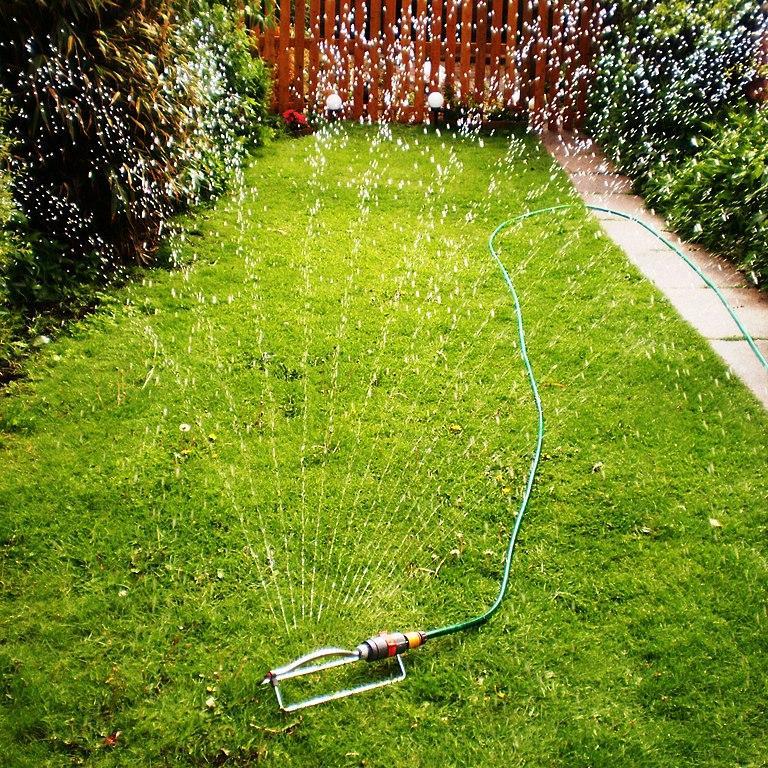
An oscillating sprinkler like the one shown above is one of the most common sprinklers used in yards.
However, oscillating sprinklers don’t always come with instructions, leading to much confusion among homeowners. For example, one of the most common questions on our website is how long you should water your lawn with oscillating sprinklers.
Established grass needs about one and two inches of water every week. So, start by determining the water flow of your sprinklers and then figure out how much time it takes to disperse an inch of water.
In general, 15 minutes in each zone of a yard should be enough to water the grass when using oscillating sprinklers.
That said, there is much more to watering your lawn with oscillating sprinklers.
Continue reading on to find out!
RELATED: How To Water Your Lawn For Best Results? & How Often Should You Do It?
What Is An Oscillating Sprinkler?
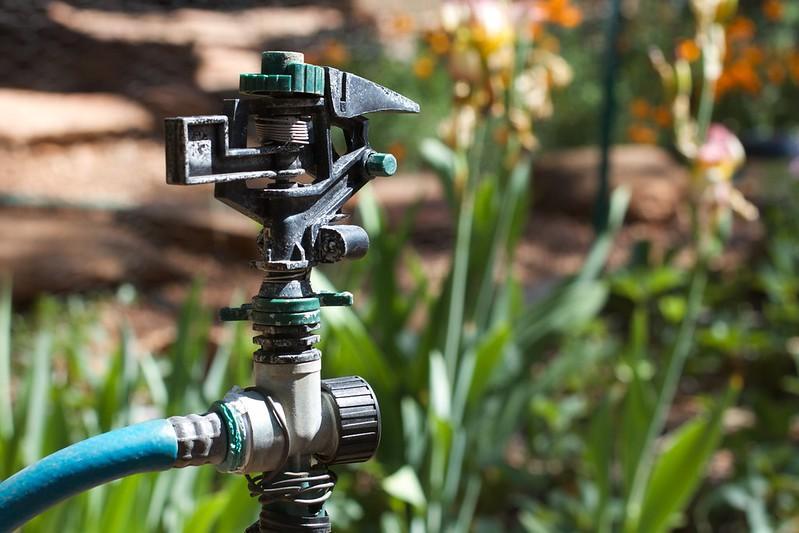
An oscillating sprinkler features a single arm that oscillates across a 180-degree plane.
Like the one shown in the picture above, oscillating sprinklers are arguably one of the world’s most commonly used lawn sprinklers. They have moving parts that undulate back and forth to provide a gentle spray ideal for watering grass, flowers, and young plants.
The undulating or oscillating arm of these sprinklers also allows them to disperse water over larger areas, so you will not have to move around your sprinklers as often.
It is one of the main reasons why oscillating sprinklers are so famous for large yards.
Oscillating Sprinkler Basics
Here is a generalized description of a regular oscillating sprinkler that you might buy online or at a gardening store, along with a brief account of its parts:
- Probably the first part that you will come across on an oscillating sprinkler is its connector. The connector is used to attach the sprinkler to the hose.
- Most of the oscillating sprinklers these days also come with a knob. The knob is used to adjust the water flow of the sprinkler for separate lawn areas.
- Then there is the sprinkler spray arm. It is often a hollow aluminum tube with multiple small holes or nozzles spraying water over the lawn.
- You might also see a heart-shaped cam connected to the spray arm. When the sprinkler runs, the cam rotates, oscillating the arm back and forth.
All in all, as you can see, an oscillating sprinkler is a pretty simple device. The water flows into the spray arm, and with the help of the cam, the arm sprays it all over the lawn.
However, modern oscillating sprinklers also allow the adjustment of coverage area to a specific size, which offers a great deal of control and efficient water usage.
Check out the best oscillating sprinklers online at the end of this article.
Watering Grass With Oscillating Sprinklers
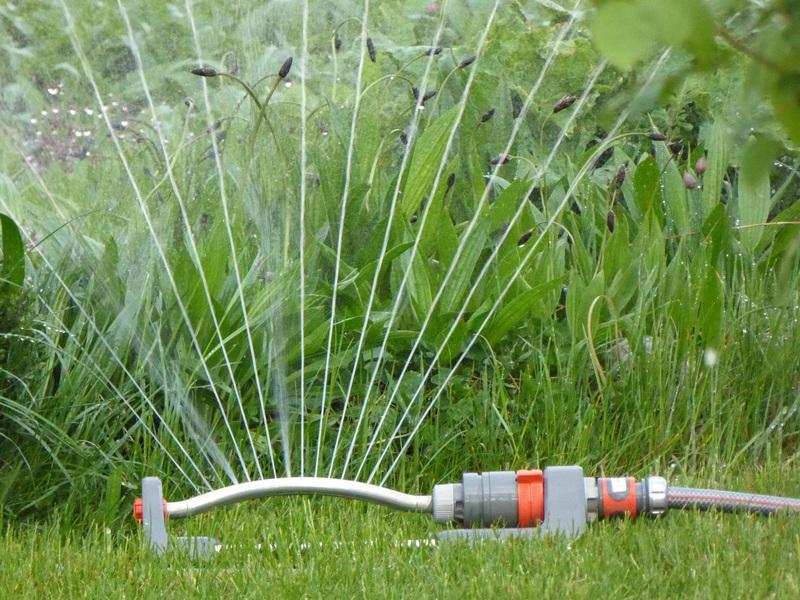
Oscillating sprinklers have a series of jets across an oscillating bar that sprays water up into the air.
If you also have oscillating sprinklers installed in your yard or are planning to install them in the future, you might have several questions. For example, will my grass get adequate moisture if I use oscillating sprinklers, or will I end up overwatering my lawn?
Issues like these, however, can be avoided by watering for the correct amount of time. But how long should you water your grass when using oscillating sprinklers?
You must follow no precise time or specific schedule when watering a lawn with oscillating sprinklers. Every yard has different needs, and not every oscillating sprinkler has the same water flow and coverage area.
Furthermore, you also need to adjust the watering time based on soil type and local weather.
So, how can you determine how much time you need to run your oscillating sprinkler to water your lawn adequately? Here is how to figure it out:
Learn How Much Water Sprinkler Puts Out
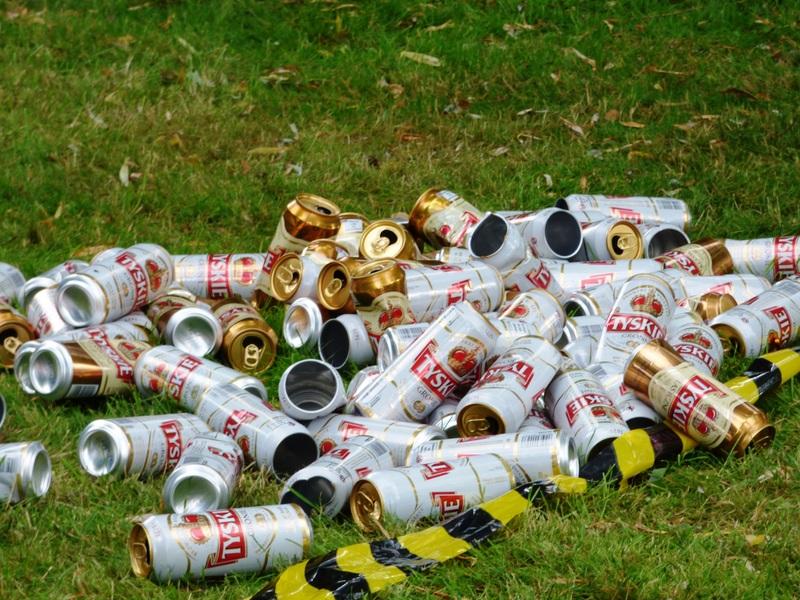
One way to measure your sprinkler’s water flow is by placing cans all over your lawn.
The first and most important step when determining how long to run your oscillating sprinklers is to measure their water flow or how much water the sprinklers spray.
There are many ways to assess it, but the best and probably the most convenient for regular home and lawn owners is the can method, which is exactly what it sounds like.
To measure the water flow of an oscillating sprinkler, experts usually recommend using a rain gauge. However, to be honest, any empty piece of Tupperware will give you an idea of what you are working with and the water flow of your oscillating sprinkler.
Nevertheless, here is how to do it.
- First of clean out some old cans. Any cans will do as long as they are a couple of inches deep. For example, coffee can, soup can, tuna can, etc.
- Next, place the cans around your lawn by eyeballing the general radius of your oscillating sprinklers. However, please ensure they are evenly spaced.
- Following that, please turn on the sprinklers and let them run for 15 minutes.
- Running the oscillating sprinklers for 15 minutes should be enough to cover your entire lawn and give you an idea of how much water your sprinklers put out.
- After 15 minutes, collect the container and measure the water level in each of them using a ruler and determine the average amount of water in the cans.
- Next, multiply the obtained answer by four, and it will give you an idea of how much water your sprinklers are putting out in an hour.
Calculating The Correct Time For Running The Sprinklers
Here is an example of the above-outlined steps to help you understand better. Let’s suppose you placed five cans around the lawn. The cans had 1.5, 1, 1.5, 0.5, and 0.5) inches of water. When added together, it comes to five (1.5+1+1.5+0.5+0.5).
So, if you divide that by five, it comes to about one inch of water for every fifteen minutes of running the sprinkler, and multiplying it by four tells you that your oscillating sprinklers will put about four inches of water if you let them run for about an hour in your yard.
In the example above, running the sprinklers for 15 minutes would be more than enough to water a lawn, as most grass types only need about one inch of water every week, either from rain or artificial irrigation. However, if it rains, things will change.
For example, if it rained 0.5 inches in the running week, you will only need to water the grass for seven and a half minutes to water the grass to about an inch. And, if it has rained for more than fifteen minutes, then we hope you have a sound drainage system installed.
RELATED: How & When To Water New Grass Seeds For A Perfect Lawn!
Consider This When Running Sprinklers
As important as it is, the water flow of your oscillating sprinklers is not the only thing that is important when determining the correct amount of time you need to run them to water the grass adequately. There are many other things and factors to consider too.
For example, and as already mentioned, you need to consider the local weather. You might have to water for slightly more duration in hot water to make up for the lost water due to evaporation. Similarly, it would help if you considered the grass type.
You even need to consider whether your grass is young or mature. So, let’s go ahead and discuss these factors one by one to help you make the most out of your sprinklers.
Weather & Climate
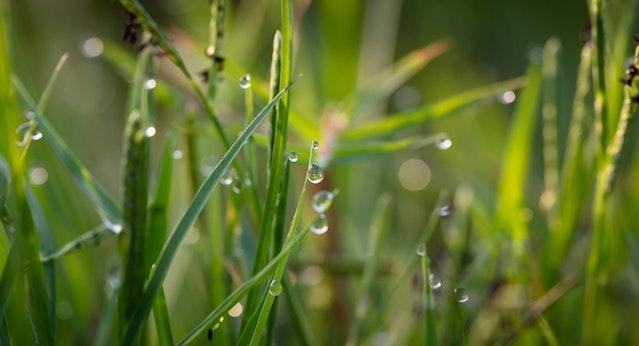
Lawns in temperate zones may receive constant showers, requiring less sprinkling.
If you have an oscillating sprinkler that sprays out about one inch of water every 15 minutes, letting it run for 15 minutes does not ensure that your grass will also receive one inch of water. For example, during hot weather, a significant amount of water being sprayed onto the lawn will be lost to evaporation and won’t be available to the grass.
So, you might have to adjust the watering time to compensate for the water loss. Similarly, as mentioned above, you must water for less time if it has rained. And it has been raining a lot; you do not need to run the sprinklers, or you may overwater the grass.
Warm-Season Vs. Cool-Season Grass Types
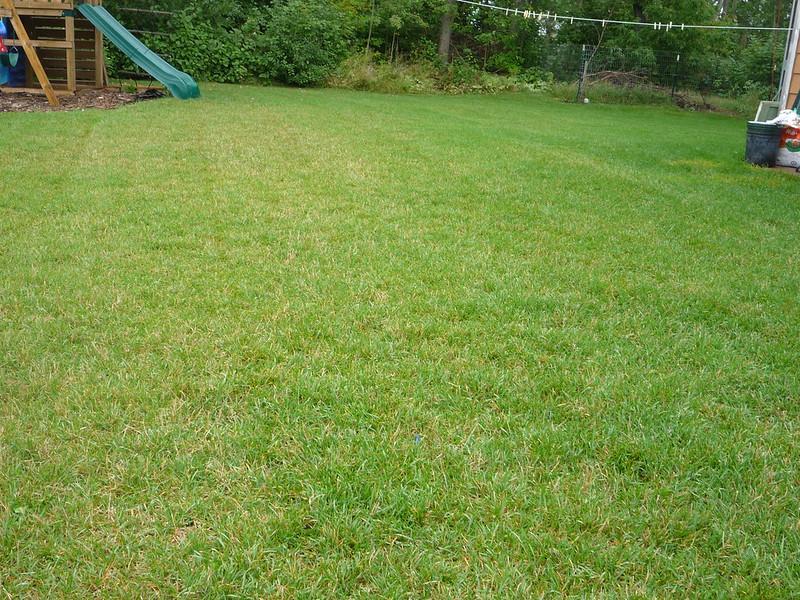
Kentucky Bluegrass might need about two to three inches of water during high heat and lower rainfall.
The oscillating sprinkler running time might need to be adjusted with the type of grass you have on your lawn. Lawn grasses are often broadly categorized into warm-season and cool-season, and both have different watering needs to survive and thrive.
Warm-season grasses, as the name suggests, thrive in hot areas and are well-adapted to drought conditions and lower rainfall. So, they might even survive with less water. However, you might need to water them daily or twice daily during scorching weather.
Examples of these grass include Bermuda grass, Zoysia grass, and St. Augustine grass.
On the other hand, there are cool-season grasses. These grasses only need about 1 to 1.5 inches of water during the colder months when they flourish and thrive.
However, when it gets hot, you will need to water them more than usual.
For example, Kentucky Bluegrass typically needs only an inch of water, but if it gets too hot outside, you must water it about two to three inches, or it will dry and die.
Therefore, you must adjust the sprinkler running time according to the grass type.
Newly Seeded Vs. Established Lawns
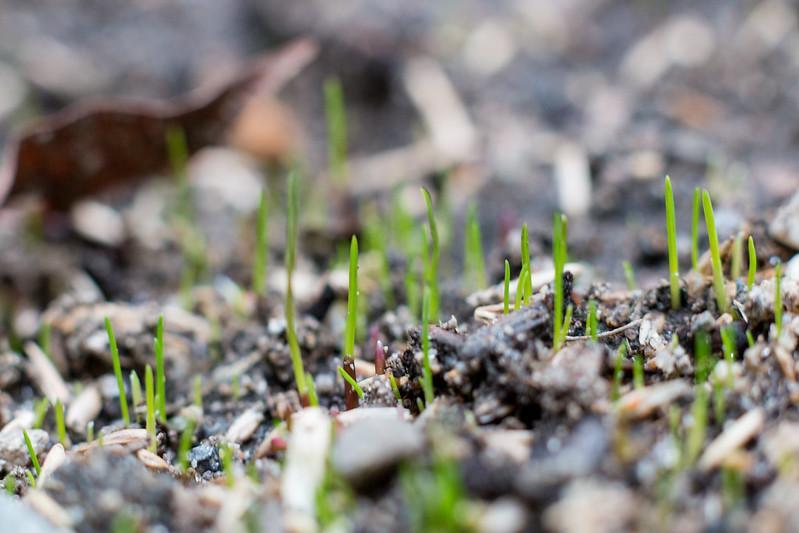
Oscillating sprinklers are suitable for watering new grass in short bursts, especially where run-off is a concern.
The ideal sprinkler running time will also vary depending on whether you have a newly seeded lawn or established grass. It is because both have different needs.
For instance, when you have just sowed seeds into the soil, the main objective is to ensure that all the seeds germinate. And to do that, you must ensure that the soil stays moist but not so moist that it becomes soggy and the seeds and seedlings suffocate.
So, you will need to water the lawn in short bursts, ideally five to seven minutes each, several times a day so that the upper one to two inches of the soil remains moist.
However, once the seedlings sprout, the aim is to ensure they develop a robust root system.
To do this, you have to water your lawn deeply. So, now you will need to water your lawn less frequently but for more time every time, you run the sprinklers so that water penetrates deep into the ground. As a result, the grass plants will develop a robust root system.
However, once the grass is fully established, you must adjust the oscillating sprinkler running time and ensure you only run them long enough to water the grass adequately.
How To Check The Moisture Level?
Now that you know a great deal about determining the correct amount of time to run your oscillating sprinklers and ensure your grass gets enough water, how can you ensure that your grass has received sufficient moisture to the desired depth?
The easiest way to check the moisture level and tell if you have sufficiently wet the ground to the desired depth is by doing the screwdriver test. And, yes, it is what it sounds like.
All you have to do is take a screwdriver or another sharp metal object. Then, try to push it into the lawn soil at different places. If it can easily be driven into the ground and, on pulling put seems moist to a few inches, the lawn is adequately watered.
However, if you have a hard time pushing it into the soil and, on taking it out, feel that it is scorched, it is probably time to let your lawn sprinkler run a bit longer.
Some Tips For Using Oscillating Sprinklers
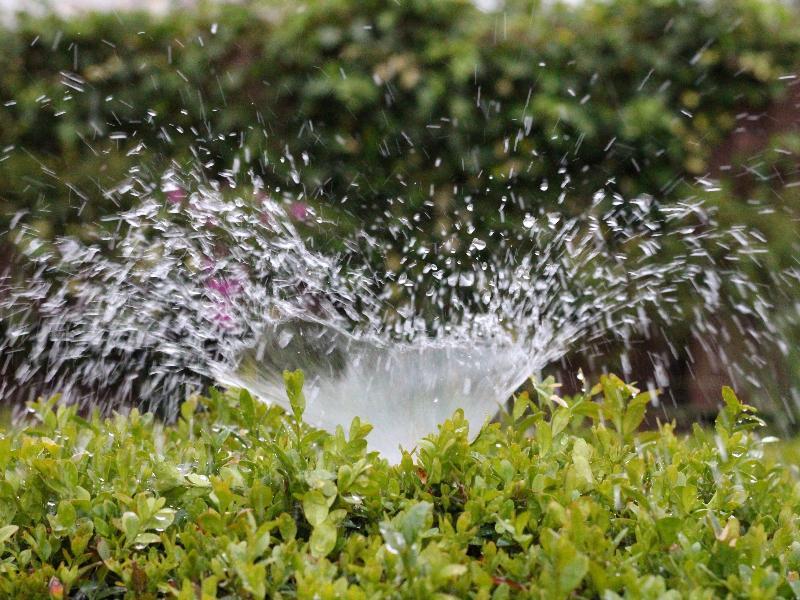
Water early morning with oscillating sprinklers to reduce evaporation and avoid strong winds.
If you have oscillating sprinklers installed, you must know that they make watering the grass easy. You don’t have to run around with a hose and still not get the job done. Nevertheless, here are some more tips to make the most of your oscillating sprinklers.
- Please do not assume the brown grass means your lawn is underwatered. It could be brown due to some disease or because it has entered dormancy. So, even if watering the grass, it won’t green up; look for a deeper cause.
- Regularly check and monitor your oscillating sprinkler system and ensure it runs smoothly. Even though rarely, sometimes, grass clippings or other debris can clog the sprinklers, leading to the uneven distribution of water on the lawn.
- Remember that most watering recommendations are just recommendations. They are not some hard and fast rules to follow. You will need to adjust watering patterns and sprinkler running time-based on the local conditions.
- Try to water your grass in the morning. It is generally cooler and less windy in the morning. It means that the soil will not be scorched from the sun’s heat, and water will not be lost to evaporation and wind blowing it away.
- If your grass has gone dormant, keep watering, and do not believe in the old myth that dormant grass does not need water. Dormant grass is still alive; it just has a reduced metabolism. So, keep it a good sprinkling now and then.
How Often You’d Run Oscillating Sprinklers?
Now that you have learned what oscillating sprinklers are, how to determine the time you need to run them for, and tips/factors to consider when using oscillating sprinklers, let’s quickly discuss how often you should run your oscillating sprinklers.
To discuss this, however, we must go back to climate, weather, and grass type.
The rule of thumb for established lawns is to water them at the recommended depths once a week. However, please remember that the recommended depth, i.e., one inch or two inches of water per week, will vary from grass type to grass type. Some grass types naturally have more water needs than other types of grass to stay healthy and green.
So, you can just water your lawn once a week, and you are good to go? Well, no! You also need to consider rain and local weather. If it rains a lot where you reside, you will have to run the sprinklers less frequently, for example, once every two weeks or not at all.
However, if you live in a drier region, the heat will evaporate the moisture much more quickly from the soil, and despite giving your grass the recommended amount of water, it will wilt. You might have to water twice or thrice a week in instances like these.
There may also be some local resources that might help you determine the right sprinkling/watering frequency for your lawn. For example, Agriculture and Natural Resources at the University of California provide this comprehensive table to help the residents determine the right frequency for watering their grass lawns.
Similarly, the city of Seattle offers this Smart Watering Guide.
RELATED: Lawn Sprinkler Types | How To Choose The Best Sprinkler For Your Lawn!
Pros & Cons Of Oscillating Sprinklers
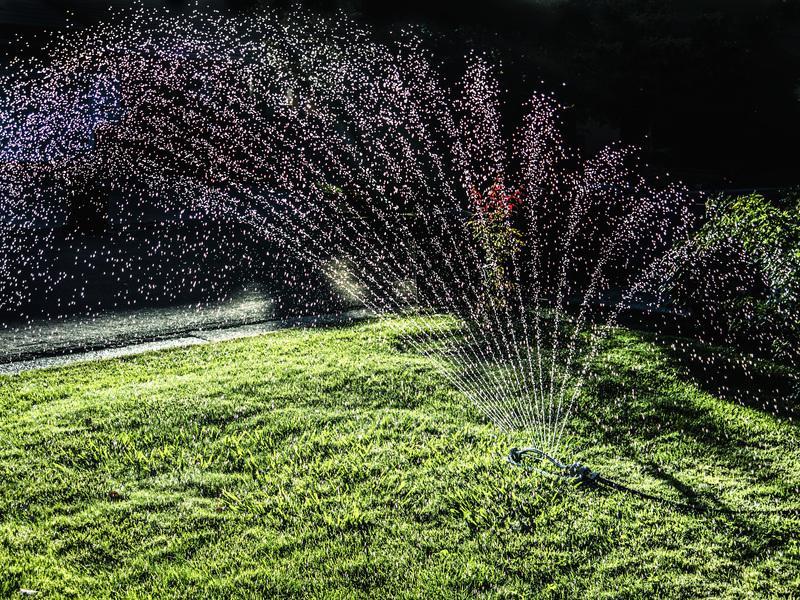
Oscillating sprinklers rotate, allowing more of your lawn to be watered at once.
If you are currently looking for a way to water your yard quickly and effectively, and one of the options you are considering are oscillating sprinklers, this part of the article is for you.
We have compiled a list of the advantages and disadvantages of oscillating sprinklers to help you make the right decision and make the most out of your money.
| Pros Of Using Oscillating Sprinklers | Cons Of Using Oscillating Sprinklers |
| Sprinkler output and range can be adjusted. Not much that can go wrong with a regular hose-and-oscillating-sprinkler system. Oscillating sprinklers are excellent for large lawns. They allow gradual water infiltration into the ground. The chances of flooding the yard are much lower. Water gets evenly and effectively spread out. Oscillating sprinklers do not leave dry spots. Oscillating sprinklers can be set to automatic. Oscillating sprinklers are cheap and plenty for rentals. Allows you to select the water output and the range. Suitable for when you need water in several areas. | They may spray water on the patio and walkways. Oscillating sprinklers are much more prone to evaporation. They are also much more affected by the wind. Sometimes, if the hose’s water pressure is too high, they shift, which could affect the watering cycle. Small sprinklers may not water the entire lawn. Some of the products may break down quickly. |
Consider This When Buying Oscillating Sprinklers
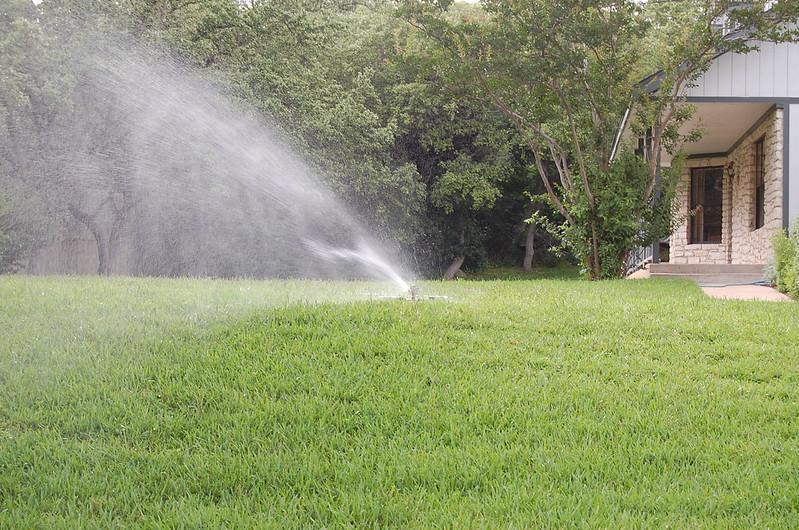
Some oscillating sprinkler models include features that make them more convenient for use.
That is all you need to know about oscillating sprinklers and using them on your lawn.
So, let’s help you buy the best oscillating sprinkler for your yard. However, before I tell you about the best oscillating sprinklers available in the market, let’s first discuss what to look for when buying an oscillating sprinkler. Let’s get started.
1. Compatibility
An essential and probably the easiest thing to miss when purchasing oscillating sprinklers is whether or not it is compatible with your garden or lawn hose. Many people spend all their time looking for high-end features in lawn sprinklers, some of which they do not even need but forget to see its compatibility with their hose system.
So, look for it. It will save you from headaches and frustration down the road.
2. Build Quality
Features and compatibility are not the only things you need to consider when buying oscillating sprinklers. You also need to look for its build quality. For instance, some oscillating sprinklers are built of cheap plastic and don’t have a UV-resistant coating.
When continuously used, these sprinklers get damaged or break down, and you will have to buy another sprinkler to get things going. Therefore, when purchasing oscillating sprinklers, please ensure that you buy excellent-quality ones with metal parts.
Even if expensive, they will pay for themselves in the long run.
3. Watering Pattern
When looking for features on an oscillating sprinkler, please pay close attention to its watering pattern. Many options are available, and some sprinklers can even be bought with custom watering patterns on the market these days.
Furthermore, when purchasing oscillating sprinklers offline, please look for ones with crossbars with adjustable directional tabs. Depending on the conditions, these directional tabs will allow you to switch between narrow and broad spraying patterns.
4. Spray Range
Every oscillating sprinkler has a different range, and it is one of the most important things to consider when purchasing an oscillating sprinkler. It goes hand in hand with the sprinkler’s area of coverage. So, when buying an oscillating sprinkler, please ensure that you buy the one that gives you a spray range per your needs and has a flow-rate dial.
The flow-rate dial will allow you to adjust the spray range per your needs, and it is a feature that often comes in handy when using multiple sprinkles on a large property.
Best Oscillating Sprinklers
Here is a rundown of some of the best oscillating sprinklers I have used.
1. Eden Heavy Duty Metal 3-Way Oscillating Sprinkler
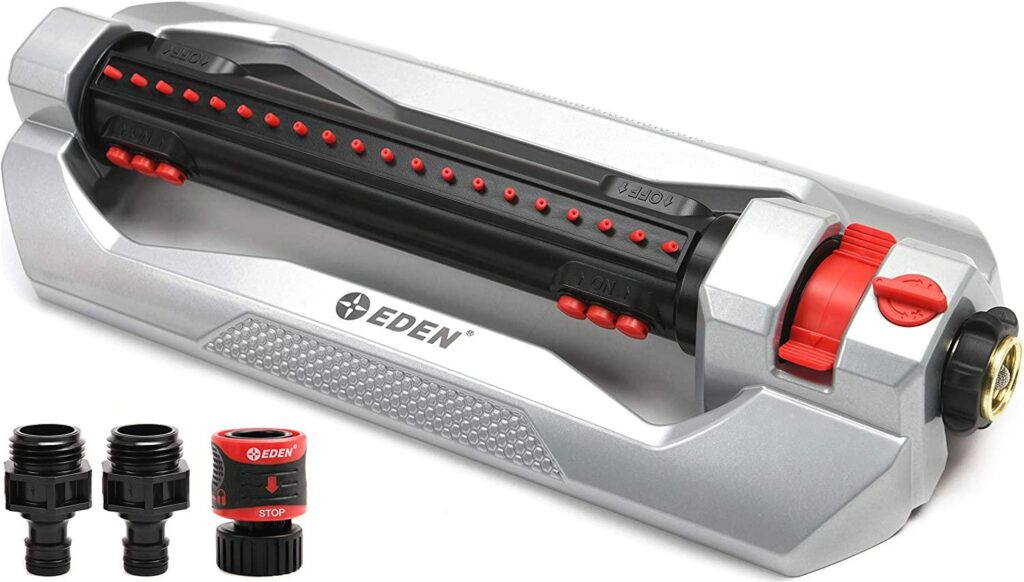
Keep your garden green and your lawn lush and beautiful with the Eden Oscillating Sprinkler.
Eden Heavy Duty Metal 3-Way Oscillating Sprinkler is the best overall oscillating sprinkler on this list with its excellent build quality and broad range. Its study metal base ensures that it does not shift when used, a common problem with oscillating sprinklers.
It can easily cover about 5,000 square feet and has an easily adjustable width and flow rate. However, in my experience, it doesn’t withstand extreme summer heat very well.
2. Melnor Turbo Oscillating Sprinkler

Interesting fact: Melnor introduced the first successful oscillating sprinkler in 1946.
Melnor 65078-AMZ XT Turbo Oscillating Sprinkler is the best sprinkler for large lawns.
Melnor Turbo Oscillating Sprinkler comes with a quick-connect adapter that attaches to a garden hose and ensures you do not waste time watering your lawn. It has a wide range and controllable flow rates and covers an area of about 4,500 square feet.
However, since this sprinkler is plastic, it might break if you are not careful.
3. GARDENA ZoomMaxx – Fully Adjustable Sprinkler
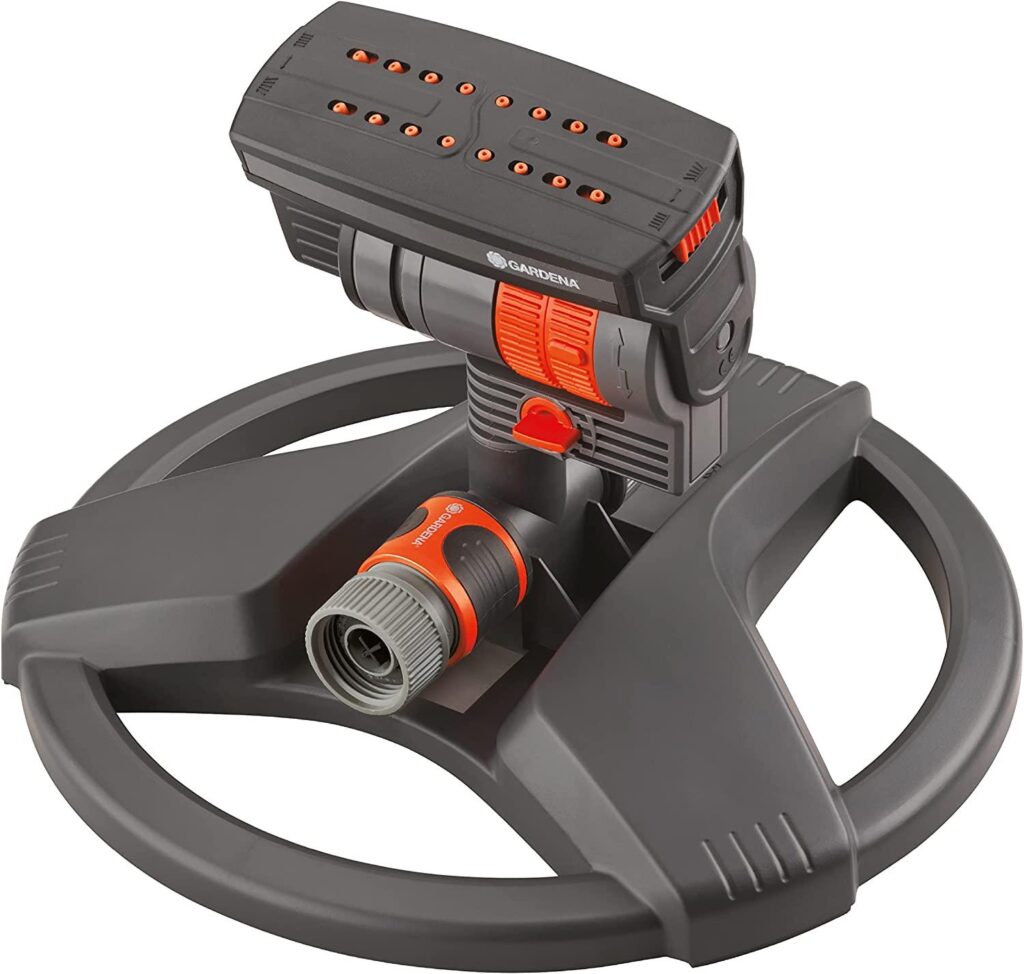
Whether it’s cold or hot, the durable material of GARDENA protects them against the weather.
GARDENA ZoomMaxx – Oscillating Sprinkler is the best sprinkler for small lawns.
GARDENA’s compact oscillating sprinkler head with many rows of nozzles makes it an excellent choice for small yards. It has several customized spray options and can be adjusted to cover areas between 76 and 2,300 square feet.
However, when I used it continually, it began to leak from several places.
4. Aqua Joe Metal Base Oscillating Sprinkler
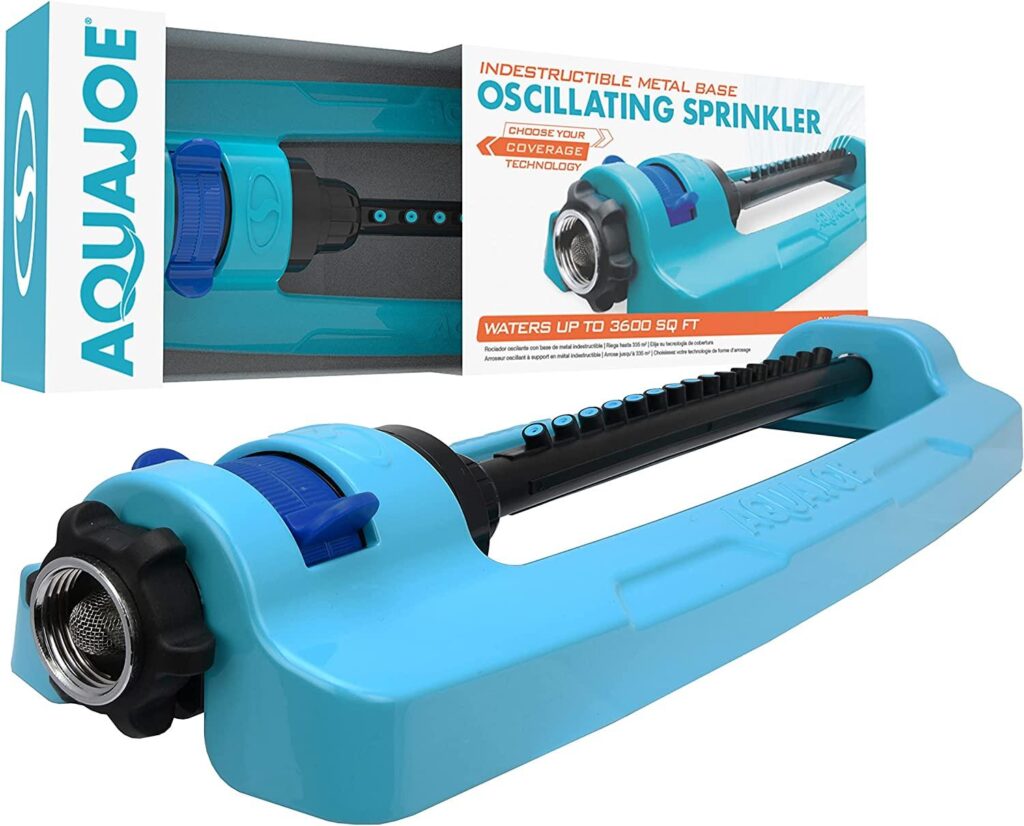
It gives you the advantage of controlling the range with easy-to-use sliding tabs.
If you’re looking for the best bang for the buck, go with Aqua Joe Sprinkler.
If you do not need all the features of a high-end oscillating sprinkler, I highly recommend you go with Aqua Joe Metal Base Oscillating Sprinkler. Despite its low price, it covers a good area of about 3,600 square feet and has a connector resistant to leaks.
However, please remember that its smaller nozzles allow less flow.
Final Thoughts
Purchasing oscillating sprinklers is easy, but using them to their full potential and correctly is where the trick lies. You must ensure that you only run them for the right amount of time; if you fail, you might overwater the grass, creating several issues.
So, please use the guidelines discussed above and go through them once more if you need to and ensure that you only run the oscillating sprinkler for the required time.
Thank you for reading this article on how long to water lawn with oscillating sprinkler. Also, check out our other articles:
Solved! How Long Do Fertilizers Take To Work? | Liquid Vs. Granular Fertilizer
The Best Organic Fertilizers For Home Lawns For A Greener & Healthier Yard
How To Identify and Treat Common Fungal Diseases Of The Lawn | A Comprehensive Guide







